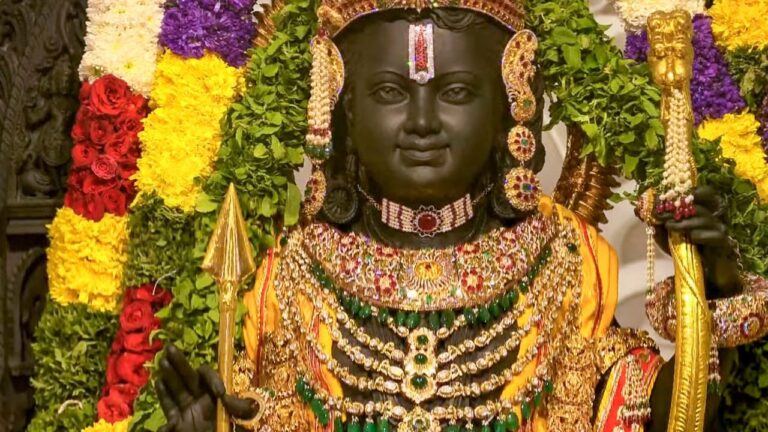News Desk, Kolkata : After a prolonged wait, the consecration of the Ram temple in Ayodhya marked the installation of the idol of Ramalala in the sanctum sanctorum. The consecration ceremony adhered to all traditional rituals. Renowned sculptor Arun Yogi Raj’s masterpiece, weighing between 150 to 200 kilograms, now graces the temple adorned with gold, silver, and diamond embellishments. Hidden within the intricacies of the sculpture are numerous symbolic elements that may not be immediately apparent to an observer.
The idol of Ramalala is intricately crafted, capturing the essence of Lord Vishnu’s ten avatars. Alongside the depiction of Lord Ram, the idol showcases the incarnations of Matsya, Kurma, Varaha, Narasimha, Vamana, Parashurama, Krishna, Buddha, and Kalki. Notably, at the right foot, there is a sculpted image of Hanuman. This meticulous portrayal aims to embody the divine narrative of Lord Vishnu’s cosmic manifestations.
Beyond its artistic grandeur, the sculpture delves into the spiritual and historical significance of the deity. It is believed that during the Treta Yuga, Lord Vishnu incarnated as Prince Ram of Ayodhya. Additionally, symbols such as the swastika and Om adorn Ram’s forehead, echoing Hindu religious motifs. The sculpture also features carved representations of the mace, discus, and conch in stone.
The consecration ceremony on a Monday was a spectacle of devotion, as the idol was adorned with a thick garland made from various flowers. A golden tilak adorned the forehead, and the rituals followed traditional practices, culminating in the establishment of the divine presence.
The story doesn’t end here. In an extraordinary feat of craftsmanship, the five-year-old Ram’s idol has been elevated within the sculpture. The saffron attire draped over the idol adds a touch of vibrancy, signifying purity and divinity. This dynamic representation captures the essence of Ram’s childhood, adding a layer of emotional depth to the divine portrayal.
The sculptor Arun Yogi Raj’s creation not only encapsulates the historical and religious narrative but also serves as a masterpiece that resonates with the devotees. The idol stands as a symbol of cultural and artistic prowess, a testament to the rich heritage embedded in the temple’s architecture.
Moreover, the consecration event saw the addition of a new element – a grand necklace adorned with diamonds, adding a sparkle to the divine presence. The artisans meticulously designed this piece, harmonizing tradition with contemporary aesthetics.
The narrative extends beyond the artistic finesse to encompass the spiritual symbolism embodied in the idol. The depiction of Lord Ram as an avatar of Lord Vishnu carries profound implications for devotees, fostering a deeper connection with the divine.
As the consecration unfolded, the entire temple radiated a sense of spiritual energy, drawing pilgrims and devotees from far and wide. The air was filled with the fragrance of flowers, and the temple precincts echoed with the sounds of devotional hymns.
In conclusion, the installation of Ramalala’s idol in the Ayodhya Ram Temple is not merely an artistic achievement but a cultural and religious milestone. It brings to life the timeless tale of Lord Ram, resonating with devotees and leaving an indelible mark on the spiritual landscape of India.
DISCLAIMER
Our news media denounces any form of bias and disapproves of sensationalism. The disseminated news is entirely educational and aimed at social awareness. Our media maintains absolute impartiality, adhering solely to the purpose of education and social consciousness.


